Sold Ceramics
Sold Famille Verte wares 1680-1725
Flowers, Animals and Long Elizas
Page 1
Several types of polychrome enamelled porcelain were developed from c.1680, during the reign of Emperor Kangxi (1662–1722). The so-called famille verte type, its decoration dominated by green enamels, was particularly popular in Europe from c. 1690–1720. The use of blue overglaze enamel was a new phenomenon, but gold was more frequently applied too. Details and outlines are often in black. It is remarkable that verte is rarely combined with underglaze blue. Apparently, the shaping and firing took place in factories in Jingdezhen that were different from the workshops where the enamelling took place.
Besides dishes, plates and bowls, luxury items such as monteiths (glass coolers) were also made. These Western shapes were modelled after pewter, glass or earthenware models. However, Western shapes occur infrequently, while Western decorations are almost non-existent. The usual Chinese decorations show a variety of flowers, animals, landscapes and figurative scenes. Much famille verte was also made for the domestic Chinese market, not just for export. Therefore, many figural decorations are based on Chinese literary sources, copying the woodcut illustrations in novels and plays. For the Western owner these decorations were nothing more than highly exotic, but for the Chinese there were all kinds of intellectual connotations. Only recently have Western scholars started investigating their meanings. One popular theme used on porcelain was the 'Western Chamber', a love story still popular today. Remarkably, European depictions in famille verte are rare.

Sold Ceramics - Sold Famille Verte wares 1680-1725 - Flowers, Animals and Long Elizas - Page 1
Object 2011684
Dish
China
c.1700
Height 55 mm (2.17 inch), diameter of rim 354 mm (13.94 inch), diameter of footring 190/160 mm (7.48/6.30 inch), weight 1.380 grams (48.68 ounce (oz.))
Dish on a channel footring, with spreading sides and a flaring rim. Decorated in famille verte enamels with two birds in flight above a fenced garden, large taihu (garden) rock on which flowerpots filled with miniature gardens with rocks, flowering prunus, pine and bamboo trees. In the centre a spotted deer with crane amongst various lingzhi growing from rockwork. On the reverse five flowering lotus sprays. Marked on the base with the symbol mark: 'Artemisia leaf', symbol for healing and wealth, in a double circle, underglaze blue. Fitted in a steel frame.
The spotted deer design symbolises best wishes for a career as an official and good fortune and prosperity. This is because the Chinese word for deer, lu, has the same sound as the word for the high salary of a Chinese official. Another reason for the association with Chinese scholar-bureaucrats or literati is that one of the concluding rituals of the provincial examinations that had to be passed if one was to become an official in the Chinese civil service was a party known as the Banquet of Auspicious Omens, ore more literally the Deer-cry Banquet.
More frequently however, in Daoist mythology the spotted deer are considered auspicious animals connected to immortality. This is because they were believed to attain great age. Furthermore, they were the only animals able to locate and eat the special fungus of longevity, lingzhi (sacred fungus). These special mushrooms were found on the paradise islands of Penglai. In Chinese mythology the Penglai mountain is often called the base of the Eight Immortals, or at least where they travelled to have a banquet. In Chinese art the spotted deer usually accompanies Shoulao or Magu, the God and Goddess of Longevity. Because of all this, even today the horns of deer have an important place in Chinese medicine and can be found in every Chinese apothecary shop. The soft internal part of the horns is dried, pulverised, and made up into pills. The inferior parts are boiled up into jelly or tincture.
The importance of spotted deer in Chinese culture today was also reflected in a gift by Taiwan to the Chinese mainland in 2011 of two rare sika or spotted deer for the Liugongdao National Forest Park in east China's Shandong Province. The sika deer is one of the very few deer species that does not lose its spots upon reaching maturity. Spot patterns vary with the region. The color of the pelage ranges from mahogany to black, and white individuals are also known. (GOV.cn Chinese Government's Official Web Portal), (wikipedia.org)
Next to the Fêng (vide Phoenix), the crane (grus motignesia) is an auspicious symbol, representing longevity and wisdom, it is the mostly celebrated in Chinese legends, in which it is endowed with many mythical attributes. It is reputed as the patriarch of the feathered tribe and the aerial courser of the Immortals. It is one of the commonest emblems of longevity, being generally depicted under a pine tree-also a symbol of age. (Williams 1976, pp.332-333), (Jörg 2011/2, p.115)
This dish has a channel footring. It is still not known what its function may have been, but possibly the dish - filled with food or offerings - was meant to be placed on a wooden stand, which would have made it more stable. Dishes with channel footrings first appear in the 1670s and were made until c.1700; they no longer appear in 18th-century assortments. (Jörg 2011/2, p.49)
Condition: Some missing pieces of blue enamel and some wear to the iron-red decoration. Three shallow chips and various glaze rough spots to the rim.
References:
Price: Sold.
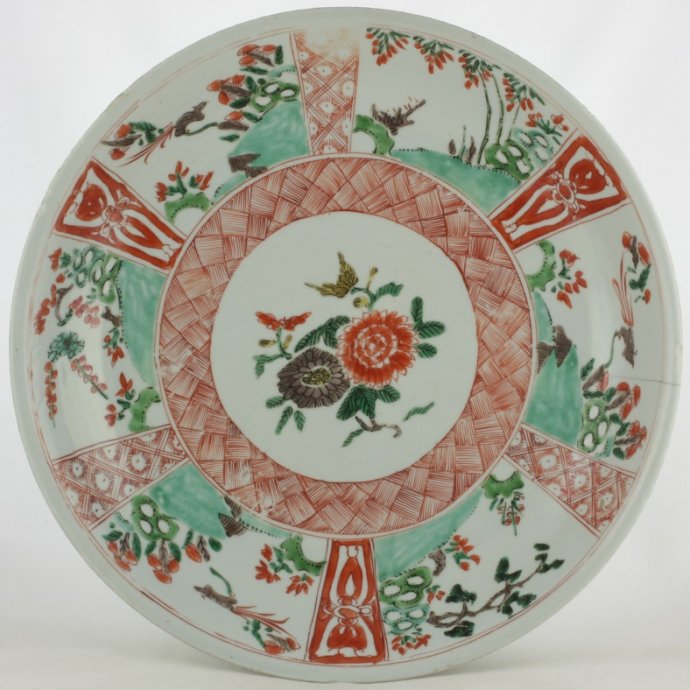
Sold Ceramics - Sold Famille Verte wares 1680-1725 - Flowers, Animals and Long Elizas - Page 1
Object 2012071
Dish
China
c.1700
Height 60 mm (2.36 inch), diameter of rim 349 mm (13.74 inch), diameter of footring 190 mm (7.48 inch), weight 1,557 grams (54.92 ounce (oz.))
Dish on footring, spreading sides and flaring rim. Decorated in famille verte enamels and iron-red with a central peony and chrysanthemum spray surrounded by a wide zig-zag lines pattern border. On the sides and rim narrow panels filled with tassels tied with a flower head or with a diaper-pattern. The large panels are filled with various flowering plants, taihu (garden) rocks and birds. Marked on the base with the symbol mark, Artemisia leaf with tassels, in a double circle, underglaze blue,
Condition: Some wear to the iron-red decoration. Two firing flaws to the base and a glaze flaw to the reverse rim. A rough rim with a hairline and some frits and chips. A frit and two chips to the footring.
Price: Sold.

Sold Ceramics - Sold Famille Verte wares 1680-1725 - Flowers, Animals and Long Elizas - Page 1
Object 2012331
Dish
China
c.1700
Height 33 mm (1.30 inch), diameter of rim 211 mm (8.30 inch), diameter of footring 114 mm (4.49 inch), weight 346 grams (12.20 ounce (oz.))
Lobed dish on a footring, with spreading sides, and a lobed rim. Decorated in typical famille verte enamels: various shades of green, overglaze yellow, gray, black, iron-red and gold with in the centre a large lotus flower head surrounded by a band of swastikas with coins alternating with swastikas with a flower head on an iron-red ground. On the sides eight radiating panels containing flowering plants alternating with a boy holding a trailing lotus on a lambent salmon ground with swastikas or scrolls in gold and flowering lotuses. Around the rim a border with flower heads alternating with lozenges filled with a swastikas on a densely painted green-speckled ('frog's-spawn') ground. The reverse is undecorated.
Most famille verte objects are decorated with flowers, flowering plants, blossoming trees, all kinds of animals including mythical ones, and slender Chinese women strolling in a garden, often accompanied by a small boy. Porcelain with flower and plant motifs, as well as landscapes without animals or figures, could be sold to Islamic customers; objects with animals and especially figures did well in the West, although a strict division certainly should not be made. Apart from studying the individual flowers and their meanings, it might also be interesting to regard the many flowers and flowering plants depicted on a piece of famille verte as symbolising a grand total, a reflection of a Chinese garden. The Chinese regard gardens as miniature landscapes, where a balance is attained between yin and yang, and the flow of rejuvenating cosmic energy (qi) is evident. (Jörg 2011/2, p.37)
The depiction of a boy or boys among foliage became a popular motif on Chinese ceramics as well as on textiles and lacquer ware. According to Confucian philosophy, abundant male offspring was considered essential to perform the duties of the family in society and the rituals and sacrifices for the deceased ancestors. Only sons guaranteed the survival of the family name. A son should pass the civil service examinations, become an official, and bring honour to his family. Lotus in this context is pronounced lian, which is a pun for lian, meaning continuous, forming the rebus of a wish for many sons. The boys are traditionally dressed as babies. Their hair is shaved, except for three small tufts of hair, the traditional hairstyle for little boys (Ströber 2011, cat. 72), (Bartholomew 2006, p.58-59, cat. 3.4 & cat. 3.4.2 & 3.16.1)
The reserved painting on the iron-red ground is characteristic of the famille verte painting programme, but because it was complicated, time-consuming and therefore expensive it was seldom produced after 1720. (Jörg 2011/2, p.50)
The salmon pigment is derived from iron oxide and was an innovation of the late Kangxi period. (Düsseldorf 2015, p.181, cat. 97)
Condition: Some glaze rough spots to the lobed rim, a fleabite and a chip to the rim and a short glaze hairline to the reverse (only visible on the reverse).
References:
Bartholomew 2006, p.58-59, cat. 3.4 & cat. 3.4.2 & 3.16.1
Düsseldorf 2015, p.181, cat. 97
Price: Sold.

Sold Ceramics - Sold Famille Verte wares 1680-1725 - Flowers, Animals and Long Elizas - Page 1
Object 2011838
Dish
China
c.1700
Height 32 mm (1.26 inch), diameter of rim 217 mm (8.54 inch), diameter of footring 117 mm (4.61 inch), weight 352 grams (12.42 ounce (oz.))
Dish on footring, flat rim. Decorated in various overglaze famille verte enamels with a bird perched on a branch of a flowering prunus tree. On the rim four panels filled with insects, reserved on a frogs' spawn ground with flowering plants and insects. On the reverse two flowering peony sprays. Marked on the base with the symbol mark: Ding incense burner, in a double circle, underglaze blue.
Condition: A sealed hairline and some, professionally restored, frits, chips and glaze rough spots to the rim.
Reference:
Price: Sold.
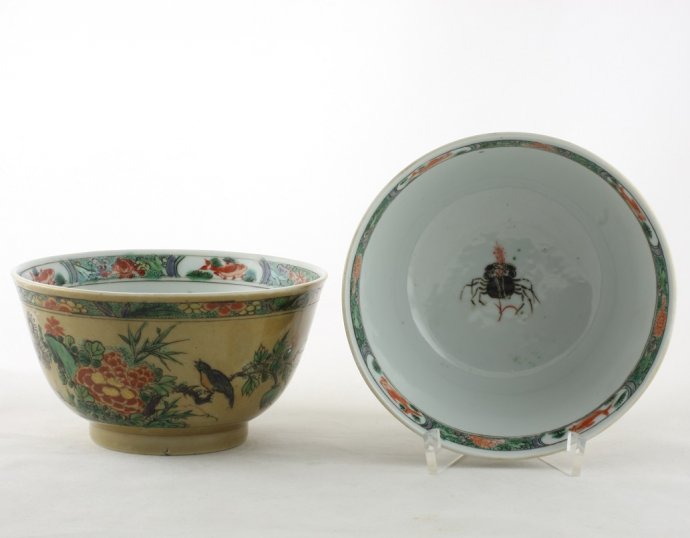
Sold Ceramics - Sold Famille Verte wares 1680-1725 - Flowers, Animals and Long Elizas - Page 1
Objects 2011494 and 2011495
Two bowls
China
1700-1720
2011494: Height 75 mm (2.95 inch), diameter of rim 135 mm (5.32 inch), diameter of footring 65 mm (2.56 inch), weight 270 grams (9.52 ounce (oz.))
2011495: Height 75 mm (2.95 inch), diameter of rim 135 mm (5.32 inch), diameter of footring 65 mm (2.56 inch), weight 272 grams (9.59 ounce (oz.))
Pair of bowls on footrings with spreading sides, slightly everted rims. Covered with a light-brown glaze. Decorated in famille verte enamels with two groups flowering plants, one with a bird the other with a grasshopper perched on a branch. The rim with a border of flower sprays on a green-speckled ground (frog-spawn). The inner rim with a border of flower sprays on a green-speckled ground and four cartouches filled with a fish among water plants. On the bottom a single crab. On the base of object 2011494 an old paper collectors label.
Natural scenes were a popular decorative design element on Chinese porcelain from the Wanli period onwards. The large grasshopper is a nice example of the interest in insects by the Chinese porcelain painters depicted on famille verte wares from c.1700. (Jörg 2011/2, p.71)
For a similarly bowl, please see:
Condition:
2011494: A firing flaw with connected frit to the footring and a chip to the rim.
2011495: Perfect.
References:
Price: Sold.

Sold Ceramics - Sold Famille Verte wares 1680-1725 - Flowers, Animals and Long Elizas - Page 1
Object 2011055
Small bowl
China
c.1700
Height 49 mm (1.92 inch), diameter of rim 85 mm (3.35 inch), diameter of footring 35 mm (1.38 inch)
Small bowl on footring with spreading sides and a slightly everted rim. Covered with a light-brown glaze and decorated in overglaze famille verte enamels, black and iron-red. The interior rim and bottom in underglaze blue. Decorated with a taihu (garden) rock, flowering plants, a butterfly, insects and a grasshopper. On the inside rim a border of zig-zag lines pattern border. On the bottom a single flowering stem. Marked on the base with the symbol mark: 'Artemisia leaf', in a double circle, in underglaze blue.
The interest of Chinese porcelain painters in insects, evident from the Wanli period onwards, is particularly apparent on famille verte wares of c.1700. It does not appear to have any special symbolic or auspicious meaning. (Jörg 2011/2, p.71)
For an identically decorated teacup and saucer, please see,
Condition: A hairline to the rim.
References:
Staatliche Schlöser und Gärten 1998, Abb. 29
Price: Sold.
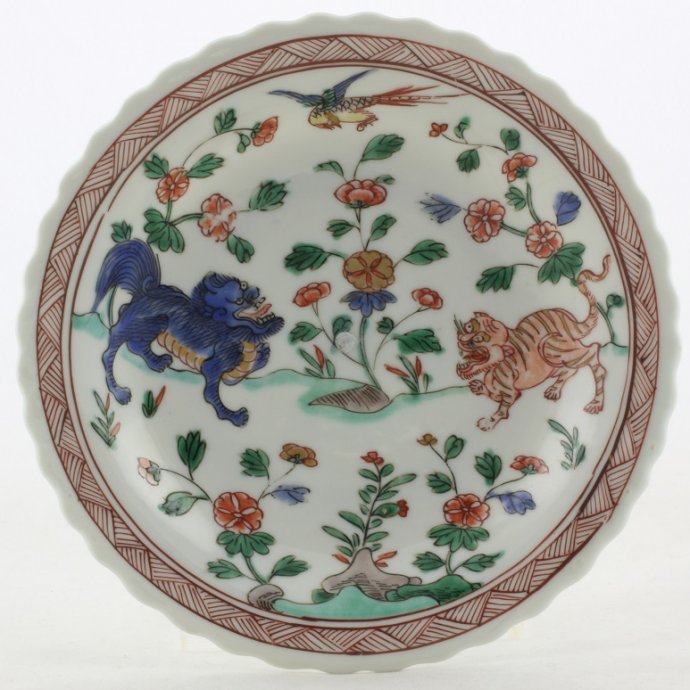
Sold Ceramics - Sold Famille Verte wares 1680-1725 - Flowers, Animals and Long Elizas - Page 1
Object 2011809
Saucer
China
1700-1720
Height: 20 mm (0.79 inch), diameter of rim 129 mm (5.08 inch), diameter of footring 61 mm (2.40 inch), weight 74 grams (2.61 ounce (oz.))
Saucer on footring, flat rim with a foliated edge. Decorated in various famille verte enamels with a qilin and a tiger in a garden, looking up at a flying pheasant. Round the rim a zig-zag lines pattern border. On the reverse three flower sprays. Marked on the base with a shop mark in a double circle in underglaze blue.
The qilin, like the dragon, the phoenix and the Black Warior tortoise, is one of the Four Divine Creatures, siling. The qilin, like the dragon, is a combination of parts, attributes and characteristics of other animals. It has a sheep's head, dragon's scales of fur, a deer's body, the feet and hooves of a horse and the tail of an ox. It can have one horn or a pair of horns on its head. These horns, unlike those of other horned creatures, are fleshly and tipped with white hair. This peculiarity makes it an animal unfit for aggression or war. The qilin for Western perception a strange and fierce-looking creature, is in Chinese mythology most auspicious. It stands for perfect goodwill, benevolence, gentleness and integrity. It is, like the phoenix, said to be very kind towards other living beings. When among other animals, they would lose all sense of their own mutual fear and would not harm each other. When a qilin appears in the world, it is always a happy omen. It comes to humanity only when great events foreshadow the birth of a sage. For this reason, it is most identified with Confucius. It is said that before his birth one appeared to his mother. The pheasant is sometimes used in the place of the phoenix, and partakes of all its attributes, being a common emblem of beauty and good fortune. The tiger is called by the Chinese the 'King of Beasts' and is the greatest of four-footed creatures, representing the masculine principle of nature. Its real or imaginary qualities afford them matter fore more metaphors than any other wild animal. (Williams 1976, p.323 & pp.398-399), (Ströber 2011, p.66)
The presence of the qilin in paintings and decorative arts can be considered a compliment to the reigning emperor. As a result of this symbolic significance, in 1662 the Kangxi Emperor, on the urgings of his advisors, instated the mythical qilin as the highest symbol of rank amongst his military officers,replacing the lion on the military rank badges. There it remained untill the fall of the empire in 1911. (Bjaaland Welch 2008, pp.140-141)
The combination of these three animals (qilin, pheasant and tiger) is strange. Normally the bird in this posture should have been a phoenix. Perhaps decorating instructions were misunderstood or we must see the combination pure for decoration rather than a cultural purpose.
Condition: Restored, two re-stuck pieces to the rim and a drilled hole in the centre (now filled).
References:
Williams 1976, p.323 & pp.398-399
Bjaaland Welch 2008, pp.140-141
Price: Sold.
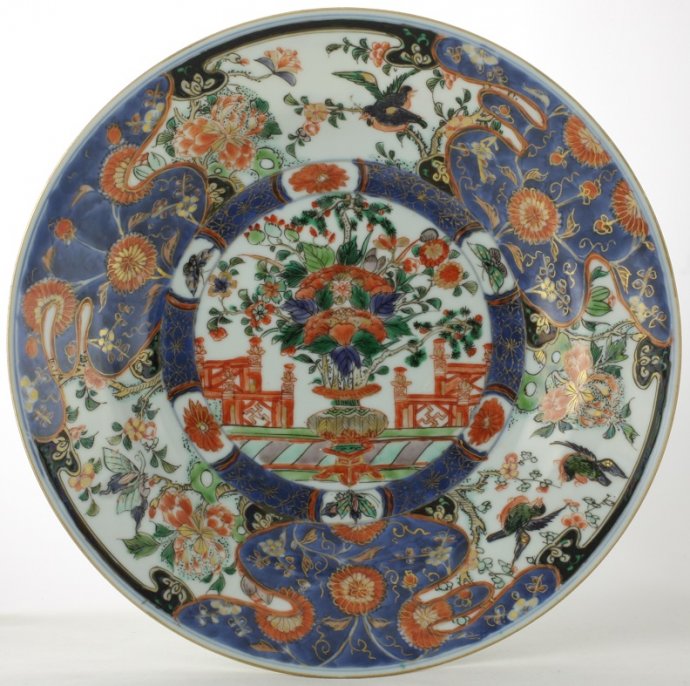
Sold Ceramics - Sold Famille Verte wares 1680-1725 - Flowers, Animals and Long Elizas - Page 1
Object 2011371
Dish
China
c.1720
Height 52 mm (2.05 inch), diameter of rim 260 mm (10.24 inch), diameter of footring 120 mm (4.72 inch), weight 479 grams (16.90 ounce (oz.))
Dish on a footring with a wide, flat underglaze brown-edged rim (jia mangkou). Decorated in underglaze blue, various famille verte enamels and gold. In the centre a vase on a stand richly filled with flowering chrysanthemum, pine and peony on a fenced terrace surrounded by a border with six cartouches decorated with a butterfly alternating with a chrysanthemum flower head. The sides and rim with three shaped panels and three flowering chrysanthemums reserved on a underglaze blue ground with scrollwork in gold. The panels are filled with flowering plants, rocks, birds or a butterfly. On the reverse rim a border with six cartouches filled with a butterfly, a fish or a shrimp; on the sides four flower sprays.
While making these dishes the Chinese potters must have been clearly inspired by Japanese Imari examples, similarities in design and technique are obvious. A large Japanese dish of this pattern is in the Museum Boymans - van Beuningen, Rotterdam. The Chinese dishes were made in various sizes, a large, 534 mm (21.02 inch), dish is in the Dresden collection of August the Strong, Elector of Saxony and King of Poland. The design is known as the 'Stanislaw pattern', named after the Polish King Stanilas Augustus Poniatowsky (r.1764-1795) who, in 1776, had earthenware copies made by the Belvedere factory in Warsaw as a present to Abdul Hamid I, Sultan of Turkey. A large part of it remains in the Topkapi Sary Museum. (Amsterdam 1972. p.35, cat. 111), (Howard & Ayers 1978, vol. 1, pp.144-145)
For this Polish earthenware copy, please see:
- Porcelain for Palaces. The Fashion for Japan in Europe 1650-1750, (J. Ayers, O. Impey & J.V.G. Mallet, Oriental Ceramic Society & The British Museum, London 1990), p.253, cat. 285.
- A game of bowls, sale catalogue Cohen & Cohen, London 2014, p.27, cat 20
For identically shaped and decorated Japanese (c.1700) and Meissen (c.1725-30) dishes, please see:
Jörg suggests that the design served as a model for close copies in Polish earthenware, made for the Polish King Stanislaw II Poniatowsky (r.1764-1795) as additions to his set of Chinese originals. One of these copied earthenware dishes from the Poniatowsky service is now in the Metropolitan Museum of Art, New York. In the late 18th century the design was also copied by the Cozzi factory in Italy. (Ayers, Impey & Mallet 1990, cat. 285), (Jörg 2011/2, p.52)
The vase filled with various kinds of flowers, derives from Chinese Kraak porcelain and symbolises riches and abundance. It is seen as an attribute of Lan Caihe, one of the "Eight Daoist Immortals" and patron of gardeners It was a highly popular motif, appearing on many Jingdezhen underglaze blue and polychrome porcelains. (Pinto de Matos 1996, p.273), (Jörg 2011/2, p,60)
For identically decorated dishes, please see:
- China for the West. Chinese Porcelain and other Decorative Arts for Export illustrated from the Mottahedeh Collection, (D.S. Howard & J. Ayers, Philip Wilson Publishers for Sotheby Parke Bernet Publications, London 1978), vol. 1, pp.144-145, cat. 126.
- Important Chinese Export Porcelain from the Mottahedeh Collection, (Sotheby's, New York, Wednesday, January 30, 1985), lot 75.
- Porzellan aus China und Japan. Die Porzellangalerie der Landgrafen von Hessen-Kassel, (Staatliche Kunstsammlungen Kassel, Berlin 1990), p.356, cat. 139a-d.
- Famille Verte, Chinese Porcelain in Green Enamels, (C.J.A. Jörg, Schoten, 2011), p.52, cat. 47.
- Collecting Chinese and Japanese Porcelain in Pre-Revolutionary Paris, (S. Castelluccio, The J. Paul Getty Museum, Los Angeles 2013), p.88 Fig. 64.
Condition: Some wear to the golden decoration, a fleabite to the rim and some shallow fleabites and frits to the footring.
References:
Howard & Ayers 1978, vol. 1, cat. 126
Ayers, Impey & Mallet 1990, cat. 285
Price: Sold.
More pictures of object 2012052, another identically, shaped, sized and decorated, sold dish >>
More pictures of object 2012052A, another identically, shaped, sized and decorated, sold dish >>
More pictures of object 2012570, another identically, shaped, sized and decorated, sold dish >>

Sold Ceramics - Sold Famille Verte wares 1680-1725 - Flowers, Animals and Long Elizas - Page 1
Object 2011643
Dish
China
c.1700
Height 33 mm (1.30 inch), diameter of rim 238 mm (9.37 inch), diameter of footring 119 mm (4.69 inch), weight 405 grams (14.29 ounce (oz.))
Dish on footring with an underglaze brown-edged 'pie-crust' rim (jia mangkou). Decorated in various famille verte enamels (green, yellow, aubergine), iron-red, black and gold with a garden scene with a fence bedecked with lotus blossom, flowers and a flowering prunus in front of two 'Long Eliza' figures, near whom is a table bearing vases on stands. The sides with a red dentate pattern border and flowering lotus scrolls on a speckled green ground with four lobed cartouches, two filled with sundry objects the other two with a shishi and a wheel of law with ribbons. Each of the small lobes of the modeled rim has a stylised lotus-petal motif. On the reverse three flower sprays.
Slender Chinese women in a garden may reflect a literary source, or may merely be depictions of beautiful ladies. (Jörg 2011/2, p. 37)
This decoration shows one of the most popular motifs of that time, the slender Chinese woman, holding a flower. In Dutch she was called a Lange Lijs, which became 'Long Eliza' in English. The 'pie-crust' rim with its tiny indented panels is modelled after a European metal or ceramic dish. (Jörg & Van Campen 1997, p.101), (Jörg 2011/2, p.42)
For a pair identically sized and decorated dishes, please see:
For identically shaped dishes decorated in famille verte enamels, please see:
- Aziatische Ceramiek uit vijf eeuwen, exhibition catalogue of the J.M. van Diepen Collection, (D.F. Lunsingh Scheurleer, Fraeylemaborg Slochteren, 1977), p.58, cat. 148.
- Jan Menze van Diepen Stichting. Selectie uit de collectie Oosterse keramiek (Jan Menze van Diepen Foundation. A Selection from the Collection of Oriental Ceramics), (C.J.A. Jörg, Jan Menze van Diepen Stichting / Jan Menze van Diepen Foundation, Slochteren 2002, p.117, cat. 79.
- Famille Verte, Chinese Porcelain in Green Enamels, (C.J.A. Jörg, Schoten, 2011), p.42, cat. 31 & 32.
For octagonal shaped dishes with identical 'pie-crust' rim, decorated in famille verte enamels, please see:
- Christie's pictorial history of Chinese ceramics, (A. du Boulay, Phaidon-Christie's, Oxford 1984), p.261, cat. 12.
- Chinese Export Porcelain from the Museum of Antastácio Gonςalves, Lisbon, (M.A. Pinto de Matos,Pilip Wilson Publishers Limited, London / Instituto Português de Museus, Lisbon, 1996), pp.202-203, cat. 109 & 110.
Condition: Restored.
References:
Lunsingh Scheurleer 1977, cat. 148
Pinto de Matos 1996, cat. 108, 109 & 110
Jörg & Van Campen 1997, cat. 91
Jörg 2011/2, p.37 & cat. 31 & 32
Price: Sold.
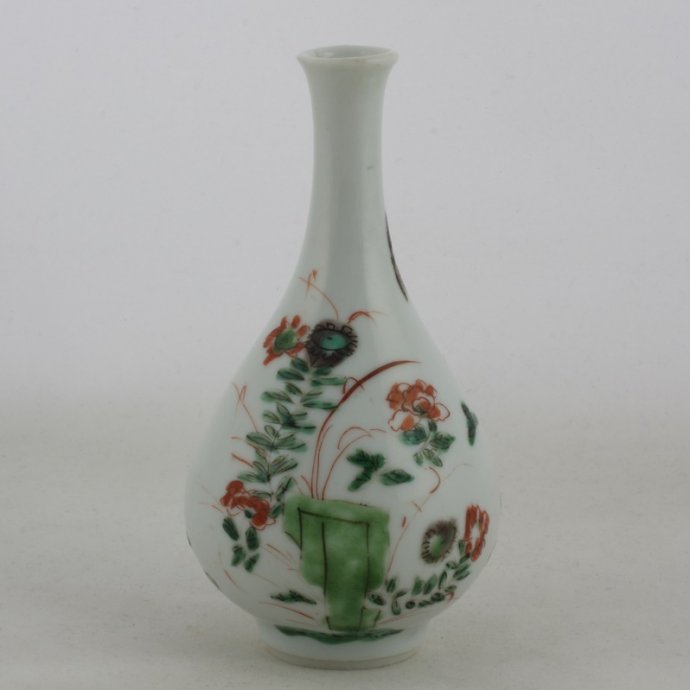
Sold Ceramics - Sold Famille Verte wares 1680-1725 - Flowers, Animals and Long Elizas - Page 1
Object 2012014
Small vase
China
c.1700
Height 105 mm (4.13 inch), diameter of mouthrim 15 mm (0.59 inch), diameter of footring: 23 mm (0.90 inch), weight 85 grams (3.00 ounce (oz.))
Small, pear-shaped, vase on footring with a slightly everted rim. Decorated in various overglaze famille verte enamels with various flowering plants growing from rockwork alternating with three dots and insects in flight.
The decoration on this small vase is similar to that seen on smaller so called "doll's house vases" of identical shape that were made during this same period. This particular small vase is however too large to be classified as a "doll's house vase".
Condition: A firing flaw, a frit and a restored chip to the rim, a restored chip to the inner foot ring.
Price: Sold.
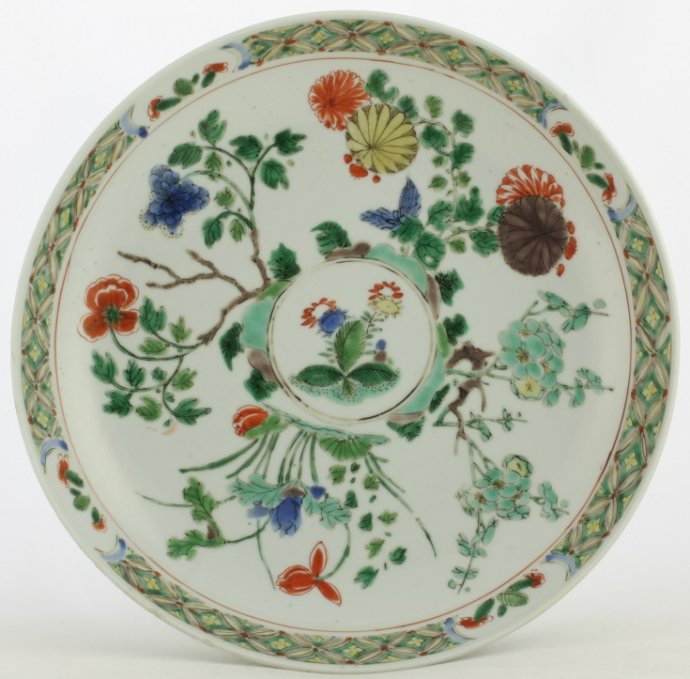
Sold Ceramics - Sold Famille Verte wares 1680-1725 - Flowers, Animals and Long Elizas - Page 1
Object 2011669
Dish
China
c.1700
Height 40 mm (1.57 inch), diameter of rim 219 mm (8.62 inch), diameter of footring 130 mm (5.12 inch), weight 335 grams (11.82 ounce (oz.))
Dish on footring, straight rim. Decorated in famille verte enamels, including green, yellow, blue, brown, black and iron-red with a central roundel filled with a flowering aster surrounded by four groups of flowering plants: chrysanthemum, prunus, lotus and peony. On the rim a stylised lattice pattern and four cartouches filled with flowering plants. The reverse is undecorated. Marked on the base with the symbol mark: 'Artemisia leaf', symbol for healing and wealth, in a double circle in underglaze blue.
Apart from studying individual flowers and their meanings, it might also be interesting to regard the many flowers and flowering plants depicted on a piece of famille verte as symbolising a grand total, a reflection of a Chinese garden. The Chinese regard gardens as miniature landscapes, where a balance is attained between yin and yang, and the flow of rejuvenating cosmic energy (qi) is evident. (Jörg 2011/2, p.37)
For a similarly decorated dish, please see:
Condition: A chip with a connected hairline and some tiny shallow frits and fleabites to the rim.
References:
Price: Sold.
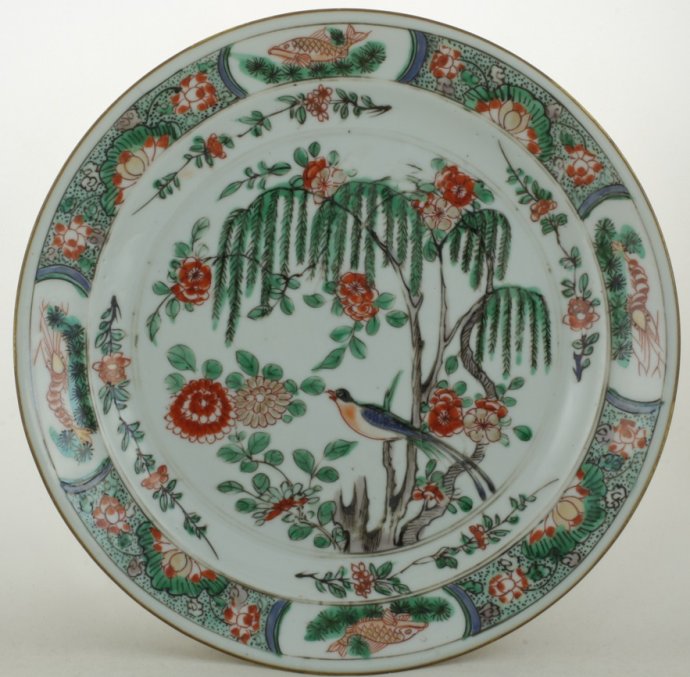
Sold Ceramics - Sold Famille Verte wares 1680-1725 - Flowers, Animals and Long Elizas - Page 1
Object 2012525
Dish
China
c.1700
Height 30 mm (1.26 inch), diameter of rim 240 mm (8.54 inch), diameter of footring 132 mm (4.61 inch), weight 376 grams (13.26 ounce (oz.))
Dish on footring, flat rim. Decorated in various overglaze famille verte enamels. In the centre flowering plants, a bird with long tail feathers on a willow branch, an insect and a butterfly. On the sides four flower sprays. The rim with a border of issuing lotus on a green-speckled ground and four reserves filled with a shrimp or a fish amongst waterweeds. On the reverse round the rim a zig-zag lines-pattern border and three elongated flower sprays. On the base a double circle in underglaze blue.
This dish is a good example of the balanced and fluent way of painting decorative elements from nature on famille verte. The fish symbolises abundance, the motif of the shrimp symbolises a wish, wanwanshun, 'may things go smoothly for you. (Jörg 2011/2, p.69, cat. 71)
For a similarly decorated dish, please see:
Condition: A restored rim and three hairlines.
Reference:
Price: Sold.
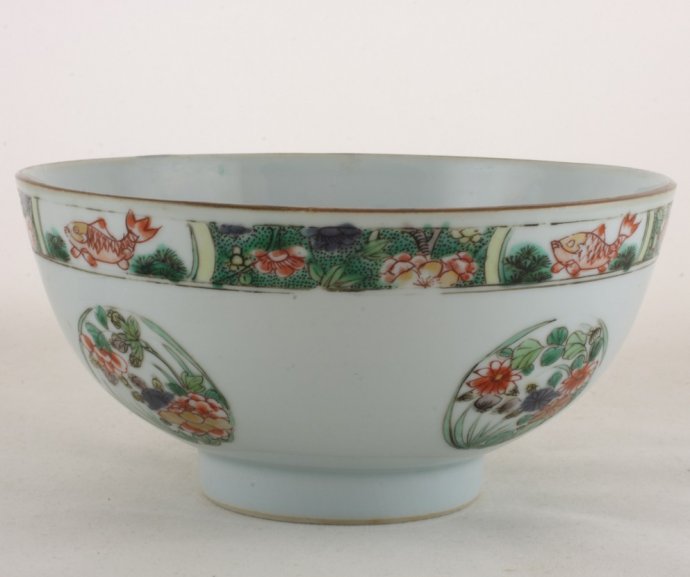
Sold Ceramics - Sold Famille Verte wares 1680-1725 - Flowers, Animals and Long Elizas - Page 1
Object 2011600
Bowl
China
1700-1720
Height 74 mm (2.91 inch), diameter of rim 150 mm (5.91 inch), diameter of footring 60 mm (2.36 inch), weight 333 grams (11.75 ounce (oz.))
Bowl on footring, straight sides and an underglaze brown-edged rim (jia mangkou). Decorated in famille verte enamels, iron-red and gold with four roundels filled with various flowering plants. Round the rim four reserves filled with fish swimming among aquatic plants alternating with flower sprays and tree trunks reserved on a frogs' spawn ground. On the bottom a lotus flower head surrounded by aquatic plants. (Sargent 2012, p.183)
Fish are among the earliest known subjects on Chinese ceramics appearing in the Neolithic period of the fifth to fourth millennium BC. Fish are rich in symbolic meaning and are a symbol of wealth and abundance. Because of the phonetic similarity between the word yu, meaning fish, and yu, meaning abundance, images of fish in Chine came to be considered emblematic of wealth and prosperity. The reproductive power of fish is regarded as a symbol of regeneration and fecundity. And because fish are thought to swim in pairs, they are reputed to be the emblem of the joys of union, particularly of the sexual kind. (Ströber 2011, p.102)
From 1745 onward, Dutch East India Company VOC records mention "fish bowls". The name "fish bowl" is somewhat misleading, since it reminds one of goldfish. But naturally here a dish is meant, intended especially to serve fish. In papers from 1752/3 we encounter both terms: the same object is sometimes called "fish bowl", at other times a "fish dish". They are always easily recognisable by the decoration: four carp among water plants. Once again, there are three types: blue-and-white, Imari and enamel colours. The blue-and-white kind has been purchased on the merchants own initiative, for it does not occur in the order for 1750. There are four smaller dishes to match each fish dish, of course with the same pattern, to be used for shrimps or butter, according to the order for 1750. (Jörg 1986/1, pp.82-85)
For others objects, decorated with fish swimming among aquatic plants, earlier sold or for sale, please see:
- Sold Ceramics - Sold Blue and White Ming wares 1368-1644 - Page 1 - Object 2010927.
- Sold Ceramics - Sold Kraak Porcelain wares 1570-1645 - Dishes - Page 2 - Object 2011068.
- Sold Ceramics - Sold Blue and White Kangxi Period 1660-1722 - Dishes - Page 3 - Object 2011071.
- Sold Ceramics - Sold Blue and White wares since 1722 - Dishes - Page 1 - Object 2011742.
- Chinese Imari 1700-1800 - Page 1 - Object 2011685.
-
Sold Ceramics - Sold Polychrome wares other since 1722 - Page 3 - Object 2011999.
- Sold Ceramics - Sold Polychrome wares other since 1722 - Page 1 - Object 2011102.
-
Sold Ceramics - Sold Famille Rose wares 1725-1800 - Dishes - Page 2 - Object 2011250.
Condition: Firing flaws to the footring and some wear to the decoration on the bottom
References:
Price: Sold.
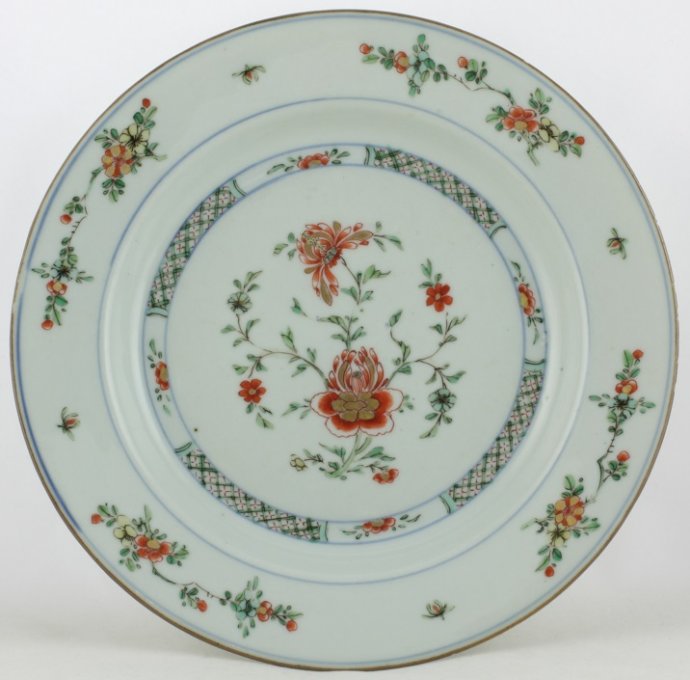
Sold Ceramics - Sold Famille Verte wares 1680-1725 - Flowers, Animals and Long Elizas - Page 1
Object 2011839
Dish
China
1720-1735
Height 31 mm (1.22 inch), diameter of rim 223 mm (8.78 inch), diameter of footring 116 mm (4.57 inch), weight 322 grams (11.35 ounce (oz.))
Dish on footring, flat underglaze brown-edged rim (jia mangkou). Decorated in underglaze blue and various famille verte enamels, iron-red and gold with a central flowerspray surrounded by a trellis pattern border with four reserves filled wirh flowerheads. The sides are undecorated. On the rim flowersprays alternating with an orchid. The reverse is undecorated.On the base the remains of a rectangular paper label that reads: 'Fam.vert 1730'
Although the new pink enamel rapidly replaced the green colour scheme after c.1725, famille verte pieces continued to be made, often in a softer palette and with more restrained decoration. (Jörg & Van Campen 1997, p.160, cat. 175) This dish is an example of that group.
Condition: Some shallow fleabites and frits to the reverse rim.
Reference:
Jörg & Van Campen 1997, cat. 175
Price: Sold.
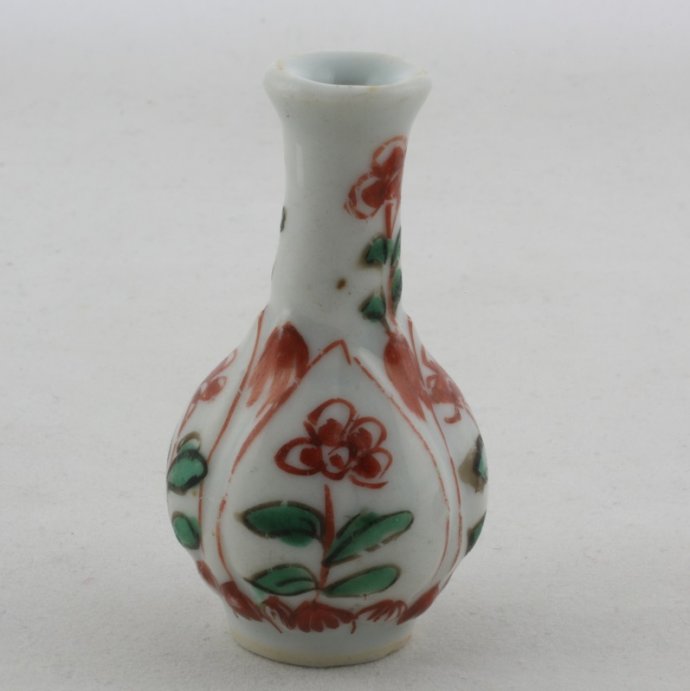
Sold Ceramics - Sold Famille Verte wares 1680-1725 - Flowers, Animals and Long Elizas - Page 1
Object 2012076
A miniature 'doll's house' vase
China
c.1700
Height 58 mm (2.28 inch), diameter 30 mm (1.18 inch), diameter of mouthrim 14 mm (0.55 inch), diameter of footring 15 mm (0.59 inch), weight 26 grams (0.92 ounce (oz.))
Moulded miniature 'doll's house' vase on footring. Decorated in various overglaze famille verte enamels with a border of ascending pointed lotus leaves around the footring, on the body six moulded panels each filled with a single flowering stem around the neck two flowering stems.
At the beginning of the 18th century, there was a fashion among wealthy Dutch ladies to have models made on the scale of a house, the so called 'doll's houses'. The rooms of these doll's houses were furnished with miniature pieces of porcelain, furniture, paintings, upholstery and all other sorts of objects that would have belonged to the interior of a wealthy home. These doll's houses were very costly and certainly not meant for children to play with but were proudly displayed for friends and visitors and regarded as extremely luxurious items - counterparts of the cabinets of curiosities that were a fashionable hobby of rich men. Only a few of these doll's houses have been preserved. One example can be found in the Gemeentemuseum in The Hague showing an 18th century room with porcelain miniatures in cupboards and on brackets along the wall. In reality, the majority of these "miniature doll's house vases" would have been part of the interior. A good example of an authentic porcelain room is the famous cabinet in Pommersfelden Castle, Germany, where groups of pieces on brackets are surrounded by these miniature vases lining the borders of the consoles. (Jörg & Flecker 2001, pp.50-51)
Condition: Perfect.
Reference:
Price: Sold.
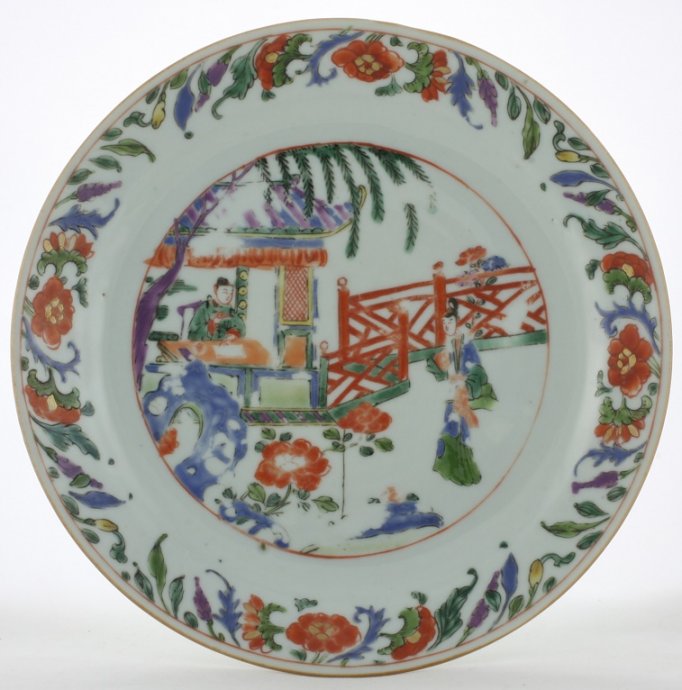
Sold Ceramics - Sold Famille Verte wares 1680-1725 - Flowers, Animals and Long Elizas - Page 1
Object 2011117
Dish
China
1720-1725
Height 28 mm (1.10 inch), diameter 237 mm (9.33 inch), diameter of footring 130 mm (5.12 inch)
Dish on footring, straight underglaze brown-edged rim (jia mangkou). Decorated in various overglaze famille verte enamels with a woman standing in a fenced garden with a willow tree, taihu (garden) rocks and flowering plants, observing a man seated at a table inside the pavillion, On the rim flower heads with various leaves. The reverse is undecorated.
For an identically decorated dish, please see:
Condition: A shallow glaze frit to the rim.
References:
Price: Sold.



 create websites
create websites